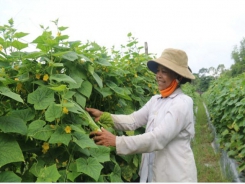Many positive signals for export of poultry, agricultural products

According to the Agro Processing and Market Development Authority under the Ministry of Agriculture and Rural Development, the acute respiratory disease caused by the Covid-19 has significantly affected agro-forestry-aquatic exports in the first two months of this year.
The total agro-forestry-aquatic exports were estimated at US$5.34 billion in the first two months of this year, down 2.8 percent compared to the same period last year. Of which, the export value of main agricultural products was estimated at $2.5 billion, down 4.3 percent; that of livestock at $74 million, down 9.6 percent; that of seafood at $932 million, down 15.9 percent.
However, the export of agricultural and aquatic products still shows positive signals. According to the MARD, the Russian Federal Service for Veterinary and Phytosanitary Surveillance (VPSS) has allowed the import of Vietnam’s processed chicken into the country. This means that Vietnam’s processed chicken products could also enter other markets in the Eurasian Economic Union.
Earlier, Vietnam’s Department of Animal Health proactively and zealously negotiated with the VPSS on veterinary hygiene requirements for processed chicken. To be able to export processed chicken to these choosy markets, Vietnam has to meet standards of raising, slaughtering, and processing chicken in chains, ensuring biosecurity, disease-freeness, food safety, and traceability.
The first enterprise that was granted permission to export processed chicken products into Russia is CP Vietnam. The fact that the export market of Vietnam’s processed chicken is expanded to more countries not only helps to increase the added value of Vietnam’s poultry farming industry but also opens a new direction for farmers, lessening dependence on the domestic market, thereby improving the position of the country’s husbandry industry.
According to the Vietnam Trade Office in Australia, it is necessary to diversify fresh agricultural products exported from Vietnam to Australia, especially the products that can be exported immediately without negotiations for market opening. After a meeting with Australian importers last week, the representative of the trade office assumed that fresh asparagus is the suitable farm produce with high value.
Currently, Vietnam’s asparagus is not available in the Australian market while Australia is the country that imports lots of asparagus, mainly from Mexico and Peru. Last year, asparagus exports into Australia nearly touched $18 million. Meanwhile, Vietnam has a plentiful supply of asparagus as the plant is grown in many places across the country, such as Quang Nam, Quang Ngai, Binh Thuan, and Hanoi.
The trade office has worked with Australian importers to prepare for the import of asparagus from Vietnam right in March this year and they plan to import asparagus steadily from Vietnam. Exporters, cooperatives, and farmers who meet requirements on biosecurity can participate. The trade office hopes that by looking for opportunities to diversify export products, it will help farmers to less concentrate the production on just a few products that might lead to many risks when the market fluctuates.
If Vietnam’s asparagus can build its brand name in Australia, thereby creating its reputation, it will open a big opportunity for a promising agricultural product in the global market. Asparagus exported to Australia do not require an import license. However, the consignments will be checked for compliance with biosecurity requirements under Australia’s regulations. Most importantly, asparagus is not infected with thrips (Thripidae).
Có thể bạn quan tâm
Phần mềm

Phối trộn thức ăn chăn nuôi

Pha dung dịch thủy canh

Định mức cho tôm ăn

Phối trộn phân bón NPK

Xác định tỷ lệ tôm sống

Chuyển đổi đơn vị phân bón

Xác định công suất sục khí

Chuyển đổi đơn vị tôm

Tính diện tích nhà kính

Tính thể tích ao hồ



 Vietnam overtakes Thailand in rice exports
Vietnam overtakes Thailand in rice exports  Viet Nam coffee growers warned of gloomy future
Viet Nam coffee growers warned of gloomy future